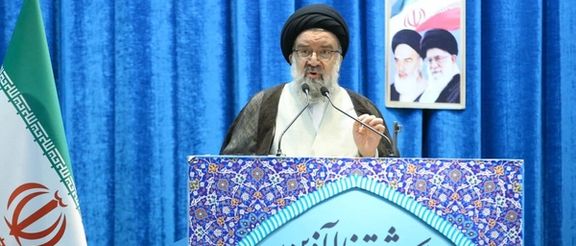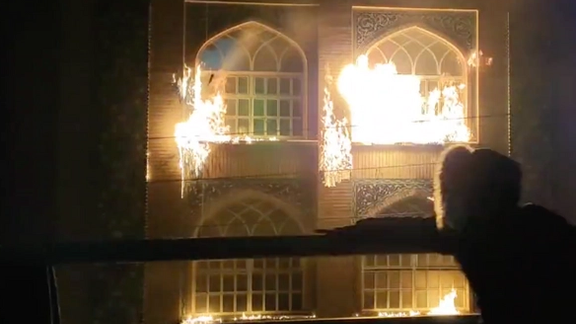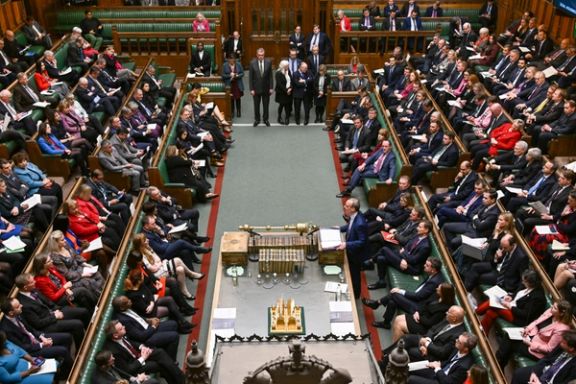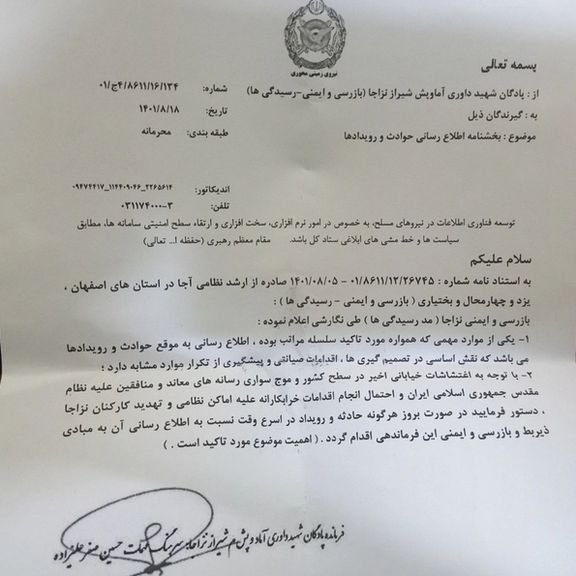Three Basij Militiamen Killed In Iranian Religious City: State TV

Iran's state media reported on Friday that three Basij militiamen were killed during protests in the religious city of Mashhad in eastern Iran on Thursday.

Iran's state media reported on Friday that three Basij militiamen were killed during protests in the religious city of Mashhad in eastern Iran on Thursday.
Mohsen Delavari, the governor of Mashhad, said that these Basij forces were killed in “knife attacks” by people who he called “rioters”.
The authorities of the Islamic Republic call the protesters “rioters”.
According to Delavari, several “thugs and rioters” were planning to close down stores with “threats and intimidation”, but when Basijis “intervened to disperse” them “the rioters killed two Basij members and injured three others with cold weapons.”
The governor of Mashhad identified the dead as Daniyal Rezazadeh and Hossein Zeinalzadeh. Iranian state TV later identified a third Basij militiaman killed in Mashhad as “Ebrahim Ghaffarian”.
Accusing the opponents of the Islamic Republic of attacking government’s repression forces comes in a situation when hundreds of protesters have lost their lives in two months of nationwide protests due to government violence, including gunshot wounds by the security forces, law enforcement, plainclothes and Basij militiamen.
On Thursday, state media also reported that a police colonel was killed in western city of Sanandaj, and his car was set on fire. On Wednesday, it was also reported that a commander of a special unit of the police force was killed in central city of Esfahan.

Iran's clerical regime signaled in Friday sermons that it will not compromise in meting out tough punishment to protesters, calling them rioters and enemies.
The message was delivered by Tehran’s Friday Prayer Imam and firebrand cleric Ahmad Khatami, who said according to religious principles, any attempt to weaken the regime is “haram” or forbidden and “we should deal with rioters using the toughest punishments.”
Friday prayer imams routinely send messages on top priorities and policies of the regime's hardliner core, controlled by the office of Iran's ruler Ali Khamenei.
Khatami categorized protesters into “murderers”, people “opposing God” and those who “spread lies and agitate public opinion”, saying that all are subject to death penalty.
Earlier this month, 227 hardliner members of Iran’s parliament sent a letter to the Judiciary asking for the death penalty for some protesters. The Judiciary, controlled by Supreme Leader Ali Khamenei has already sentenced several detainees to hanging.
But before detaining people, security forces resort to extreme violence on the streets, using any weapon they have without regard to age, gender or risk involved. Those who have military weapons shoot to kill.
Estimates by human rights monitoring organizations have put the death toll of protesters killed by a variety of regime forces at a minimum of 350 since mid-September. Estimates also say that around 15,000 have been arrested.
Officials, following the initial signal by Khamenei, have dubbed the two-month-old protests “riots” and the protesters “rioters”. Some of those arrested have been charged with “moharebeh” or fighting God, which is the most serious offense in Iran’s Islamic law and can trigger the death penalty. Many others among thousands of detainees will probably face the same accusation.
Khatami tried to balance his tough words by saying that “protests are not forbidden in Islam,” and the regime was only reacting to “rioters”, but the fact remains that security forces used force against the first small gatherings on September 16 when news broke that the 22-year-old Mahsa Amini had died in hospital after being beaten on the head by ‘morality police’.
According to the constitution, unarmed citizens are allowed to protest, and the interior ministry is supposed to receive applications and issue permits for assembly. But except government rallies, no group has ever received a permit for a protest.
Khatami blamed the government’s use of force on “rioters burning ambulances,” while hundreds of videos published in two months shows security forces attacking all gatherings everywhere, independent of what protesters might have done or not.
The hardliner cleric in his sermon also revealed the true thinking of the ruling circles, saying that the protesters’ aim is “overthrowing the regime” and this will not be tolerated. He also admitted that protests are weakening the foundations of the governing system.
Khatami also mentioned Iran’s dismemberment, a danger the government loves to speak about since protests broke out, to scare the average citizen from the consequences of the antigovernment movement. He claimed that Western countries plotting against Iran will be disappointed to see unity prevailing.
However, there has been little evidence of any separatist influence among protesters, who all emphasize ethnic solidarity between different regions of the vast country.
In fact, Mahsa Amini was a Kurd from a Kurdish city, but people in other parts of the country immediately came out to protest her killing in police custody.

During intense unrest Thursday night, antigovernment protesters set fire to the house and museum of Ayatollah Ruhollah Khomeini, the founder of the Islamic Republic.
This was the ultimate act of defiance against the clerical regime that has failed to control nationwide protests since mid-September. The demonstrations have turned into a popular movement, reaching the farthest corners of the country, that simply aims to overthrow the Islamic Republic.
The demonstrations Thursday night commemorating those killed by government forces in the past few days drew into the night while protesters set fire to government buildings and seminaries.
In Khomein, the birthplace of Ayatollah Khomeini, people attacked and torched his family house which was turned into a museum in recent years. This unprecedented act of defiance became a sensation on Persian social media, with tens of thousands of people watching and sharing the video of the incident.
Videos show angry demonstrators also set fire to a seminary in the religious city of Qom near Tehran, as young people have targeted clerics in the street for verbal abuse and flipping their turbans off their heads.
Stones and Molotov Cocktails have become the main weapons for protesters who pelt anti-riot forces and set fire to large government propaganda banners in the streets. They also attack police stations and more often torch buildings used by the Revolutionary Guard’s Basij militia, who play a major role in attacking and killing protesters.
Government media said Friday that three Basij militiamen were killed Thursday in the religious city of Mashhad, while videos emerged showing other government agents wounded and running naked in the streets.
Overnight protests were also staged in scores of cities including Mashhad, Shahrekord, Masal, Sanandaj, Esfahan, Arak, Yazd, Saqqez, Lahijan, Bandar Abbas, Bijar, and Kermanshah. The geographic distribution of these cities covered from the northeast to the south and west of the country, with large protests also in central Iran.
Anit-regime slogans were chanted in tens of neighborhoods in capital Tehran.
Security forces fired live rounds and tear gas in several cities to crack down on the protesters.
In Bukan, people attacked government buildings torching a justice ministry office.Protesters in Rasht, also set fire to the office of a member of parliament.
Angered by killing of a 10-year-old child in Izeh in the oil-rich Khuzestan province, activist groups have called for mass protests across 20 cities on Friday.
According to Oslo-based Iran Human Rights Organization, at least 342 people including 43 children and 26 women had been killed by security forces in the ongoing nationwide protests until Wednesday.
Thousands have also been arrested in the last two months, with some being at risk of receiving death sentences for security-related charges.
Friday is expected to be another intense day of protests, as anonymous activists have called for continuing nationwide demonstrations until Monday, November 21.

Security forces have attacked people attending the funeral ceremony of a 23-year-old woman who was killed by regime forces in the northwestern city of Tabriz.
People chanted slogans at the clerical regime during the burial ceremony of Aylar Haqqi on Friday morning in the presence of a large crowd of mourners in Tabriz cemetery.
Aylar Haqqi, a medical student had reportedly taken refuge in a building during Wednesday demonstrations, where the regime agents found her and pushed her from the top of the building. A rebar pierced through her abdomen and out from her back. However, the regime announced she had died after falling into a construction dig.
Meanwhile, some sources quote a relative of Aylar saying she has been killed by direct fire of security forces, but in order to deliver her body to her parents security agents forced them to say she died after falling from top of a building.
Reports on social media say another young person named Ali Araghi was also killed in Tabriz on Wednesday night.
Meanwhile, an anonymous group called Freedom-seeking Revolutionaries of Azarbaijan in a statement called on people in all cities of the province to take to streets every day beginning Friday.
According to Iran Human Rights Organization, security forces had killed at least 342 people, including 43 children and 26 women as of Wednesday. There is no new estimate for the past two days of intense protests.

Iran was a hot topic at a session of the UK House of Commons Wednesday with many lawmakers concerned about the impending executions of detained prisoners.
A wide range of Iran-related topics were discussed during the session, including how the UK can help support the protesters, prevent the Islamic Republic from another round of mass executions like the ones in 1988, and how to deal with the threats posed by Iran’s Revolutionary Guard both in the region and inside the UK.
The threats against Iran International and BBC Persian journalists were also mentioned by Conservative MP Bob Blackman, Shadow Minister for the Middle East and North Africa Bambos Charalambous, Parliamentary Under-Secretary of State for Americas and Caribbean David Rutley, and Shadow Minister of State for Security Holly Lynch.
The MPs were concerned that President Raisi, who is one of the main culprits behind the 1988 prisoner massacre that led to the killing of thousands, will orchestrate a similar carnage in cooperation with the IRGC and the judiciary.

The MPs referred to the death sentences handed to several protesters this week and expressed concerns that a similar fate will be expected for a large number of protesters, particularly following a call by 227 Iranian parliamentarians who are pushing for the death penalty. Moreover, calls for proscription of the IRGC are getting stronger in the British political sphere as they are the main force that would go on with the purge.
So far, nearly 400 protesters have been reported dead – including about 50 children – and over 15,000 have been detained since the current wave of protests engulfed Iran following the death in custody of 22-year-old Mahsa Amini, it was said. However, the figures are likely much higher, but the authorities do not release any data and obscure the ways for human right groups to obtain information.
Blackman said, “Contrary to the reports that the Minister mentioned, the reports I have are that more than 60,000 people have been arrested.” He added that “President Raisi, was responsible as the prosecutor in Iran for 30,000 executions of political prisoners in 1988, so the direction from the top is very clear... We are also aware that sentencing and executions are beginning in Iran, and that many thousands of people may end up being executed.”
Rutley argued that the threats to press freedom in Iran, now extended to the UK, were a sign of the regimes growing weakness in the face of ‘grassroots’ protests.
Describing the level of violence against protesters as “utterly appalling,” Rutley said, “The UK opposes the death penalty in all circumstances, but it is all the more abhorrent when those sentenced are being arrested for standing up for their rights.”
He added that “the frequency of these death sentences is only likely to increase as the regime processes the thousands of arrests that have been made during the protests. The Iranian judicial system is notorious for its lack of transparency and process, and this barbarism is just one of many threatening and intimidating techniques that the regime has rolled out in response to the protests.”
Blackman was another MP that asked the government to proscribe the IRGC as a terrorist group, but Rutley reiterated the government’s position of not commenting on potential proscriptions.
Speaking on behalf of the opposition, Charalambous and Lynch asked about the steps the UK Government is taking to protect journalists and UK nationals critical of the regime. In response, Rutley reiterated his previous points about summoning the Iranian Chargé d’affaires and the support being provided by the police.
Citing a report from MI5 of 10 assassination attempts on British residents this year, Lynch called for measures to remove the Islamic Republic-linked actors from the UK
She also asked what steps the government was taking to remove actors linked to the Iranian government from the UK citing a report from MI5 of 10 assassination attempts on British residents this year. Rutley’s response cited the Foreign Secretary’s warning to the Islamic Republic’s chargé d’affaires and promised that the Government would continue to monitor the situation.
Other contributors to the debate repeated Bob Blackman’s request about the need to proscribe the IRGC and for the Government to do more to support the protesters. Rutley’s responses made clear the Government’s support for the protesters, but they did not announce much by way of new measures.

A new document received by Iran International shows that Iranian Army staff and their families have been supporting the popular antigovernment protests since September.
In a letter issued by a high-ranking army commander, he demanded daily reports on the arrest of army personnel and their families during protests, as well as paying attention to "subversive actions" against military facilities.
Hossein Safaralizadeh, commander of an army base in the southern city of Shiraz, has also mentioned that the army’s inspectorate has also warned other commanders in three provinces of Esfahan, Yazd and Charmahal-Bakhtiari to follow up on such cases on daily basis.
This letter may suggest that the number of army personnel who are showing sympathy toward the protest movement, or family members participating in protests is on the rise and top military officials are concerned about it.
“The presence of army personnel and their families in riots, their arrest by the security, writing anti-government slogans on the walls of the barracks, and the amount of possible damage to the barracks and army housing units must be reported daily… through text, phone, or reports,” reads the letter.
Iran’s traditional Army, as distinct from the Revolutionary Guard, is widely criticized for not acting against the brutality of Basij militiamen, IRGC forces, and police who are ruthlessly killing innocent people during the uprising.
Analysts believe that, in the past years, the Islamic Republic has provided key positions of the army to the members of the Revolutionary Guard to eliminate the possibility of forming an opposition within the army.